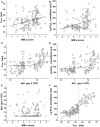Endothelial Dysfunction in Children With Obstructive Sleep Apnea Is Associated With Elevated Lipoprotein-Associated Phospholipase A2 Plasma Activity Levels
- PMID: 28183716
- PMCID: PMC5523777
- DOI: 10.1161/JAHA.116.004923
Endothelial Dysfunction in Children With Obstructive Sleep Apnea Is Associated With Elevated Lipoprotein-Associated Phospholipase A2 Plasma Activity Levels
Abstract
Background: Obstructive sleep apnea (OSA) is a highly prevalent condition, especially in obese children, and has been associated with increased risk for endothelial dysfunction and dislipidemia, which are precursors of atherosclerosis. Lipoprotein-associated phospholipase A2 (Lp-PLA2) is recognized as an independent risk factor for cardiovascular risk and atheromatous plaque activity. We hypothesized that Lp-PLA2 levels would be elevated in children with OSA, particularly among obese children who also manifest evidence of endothelial dysfunction.
Methods and results: One hundred sixty children (mean age 7.1±2.3 years), either nonobese with (n=40) and without OSA (n=40) or obese with (n=40) and without OSA (n=40) underwent overnight polysomnographic and postocclusive reperfusion evaluation and a fasting blood draw the morning after the sleep study. In addition to lipid profile, Lp-PLA2 plasma activity was assessed using a commercial kit. Obese children and OSA children had significantly elevated plasma Lp-PLA2 activity levels compared to controls. Furthermore, when both obesity and OSA were concurrently present or when endothelial function was present, Lp-PLA2 activity was higher. Treatment of OSA by adenotonsillectomy resulted in reductions of Lp-PLA2 activity (n=37; P<0.001).
Conclusions: Lp-PLA2 plasma activity is increased in pediatric OSA and obesity, particularly when endothelial dysfunction is present, and exhibits decreases on OSA treatment. The short-term and long-term significance of these findings in relation to cardiovascular risk remain undefined.
Keywords: atherosclerosis; cholesterol; endothelial dysfunction; sleep apnea.
© 2017 The Authors. Published on behalf of the American Heart Association, Inc., by Wiley Blackwell.
Figures


Similar articles
-
Elevated circulating levels of lipoprotein-associated phospholipase A2 in obese children.Clin Chem Lab Med. 2015 Jun;53(7):1119-25. doi: 10.1515/cclm-2014-1081. Clin Chem Lab Med. 2015. PMID: 25581763
-
Endothelial dysfunction in children without hypertension: potential contributions of obesity and obstructive sleep apnea.Chest. 2012 Mar;141(3):682-691. doi: 10.1378/chest.11-1777. Epub 2011 Oct 26. Chest. 2012. PMID: 22030801 Free PMC article.
-
Metabolic alterations and systemic inflammation in obstructive sleep apnea among nonobese and obese prepubertal children.Am J Respir Crit Care Med. 2008 May 15;177(10):1142-9. doi: 10.1164/rccm.200711-1670OC. Epub 2008 Feb 14. Am J Respir Crit Care Med. 2008. PMID: 18276939 Free PMC article.
-
[Does Lp-PLA2 determination help predict atherosclerosis and cardiocerebrovascular disease?].Acta Med Croatica. 2010 Oct;64(4):237-45. Acta Med Croatica. 2010. PMID: 21688606 Review. Croatian.
-
The role of lipoprotein-associated phospholipase A2 in atherosclerosis may depend on its lipoprotein carrier in plasma.Biochim Biophys Acta. 2009 May;1791(5):327-38. doi: 10.1016/j.bbalip.2009.02.015. Biochim Biophys Acta. 2009. PMID: 19272461 Review.
Cited by
-
Metabolomic profile associated with obstructive sleep apnoea severity in obese pregnant women with gestational diabetes mellitus: A pilot study.J Sleep Res. 2021 Oct;30(5):e13327. doi: 10.1111/jsr.13327. Epub 2021 Apr 1. J Sleep Res. 2021. PMID: 33792106 Free PMC article.
-
Metabolomic and lipidomic profile in men with obstructive sleep apnoea: implications for diagnosis and biomarkers of cardiovascular risk.Sci Rep. 2018 Jul 26;8(1):11270. doi: 10.1038/s41598-018-29727-6. Sci Rep. 2018. PMID: 30050090 Free PMC article.
-
Lipoprotein-associated phospholipase A2: The story continues.Med Res Rev. 2020 Jan;40(1):79-134. doi: 10.1002/med.21597. Epub 2019 May 29. Med Res Rev. 2020. PMID: 31140638 Free PMC article. Review.
-
Obstructive sleep apnea: in search of precision.Expert Rev Precis Med Drug Dev. 2017;2(4):217-228. doi: 10.1080/23808993.2017.1361319. Epub 2017 Aug 9. Expert Rev Precis Med Drug Dev. 2017. PMID: 31548993 Free PMC article.
-
Study on Relationship Between Carotid Intima-Media Thickness and Inflammatory Factors in Obstructive Sleep Apnea.Nat Sci Sleep. 2022 Dec 14;14:2179-2187. doi: 10.2147/NSS.S389253. eCollection 2022. Nat Sci Sleep. 2022. PMID: 36540195 Free PMC article.
References
-
- Katzmarzyk PT, Shen W, Baxter‐Jones A, Bell JD, Butte NF, Demerath EW, Gilsanz V, Goran MI, Hirschler V, Hu HH, Maffeis C, Malina RM, Müller MJ, Pietrobelli A, Wells JC. Adiposity in children and adolescents: correlates and clinical consequences of fat stored in specific body depots. Pediatr Obes. 2012;7:e42–e61. - PubMed
-
- Berends LM, Ozanne SE. Early determinants of type‐2 diabetes. Best Pract Res Clin Endocrinol Metab. 2012;26:569–580. - PubMed
-
- Park MH, Falconer C, Viner RM, Kinra S. The impact of childhood obesity on morbidity and mortality in adulthood: a systematic review. Obes Rev. 2012;13:985–1000. - PubMed
-
- Canas JA, Sweeten S, Balagopal PB. Biomarkers for cardiovascular risk in children. Curr Opin Cardiol. 2013;28:103–114. - PubMed
Publication types
MeSH terms
Substances
Grants and funding
LinkOut - more resources
Full Text Sources
Other Literature Sources
Medical
Miscellaneous

